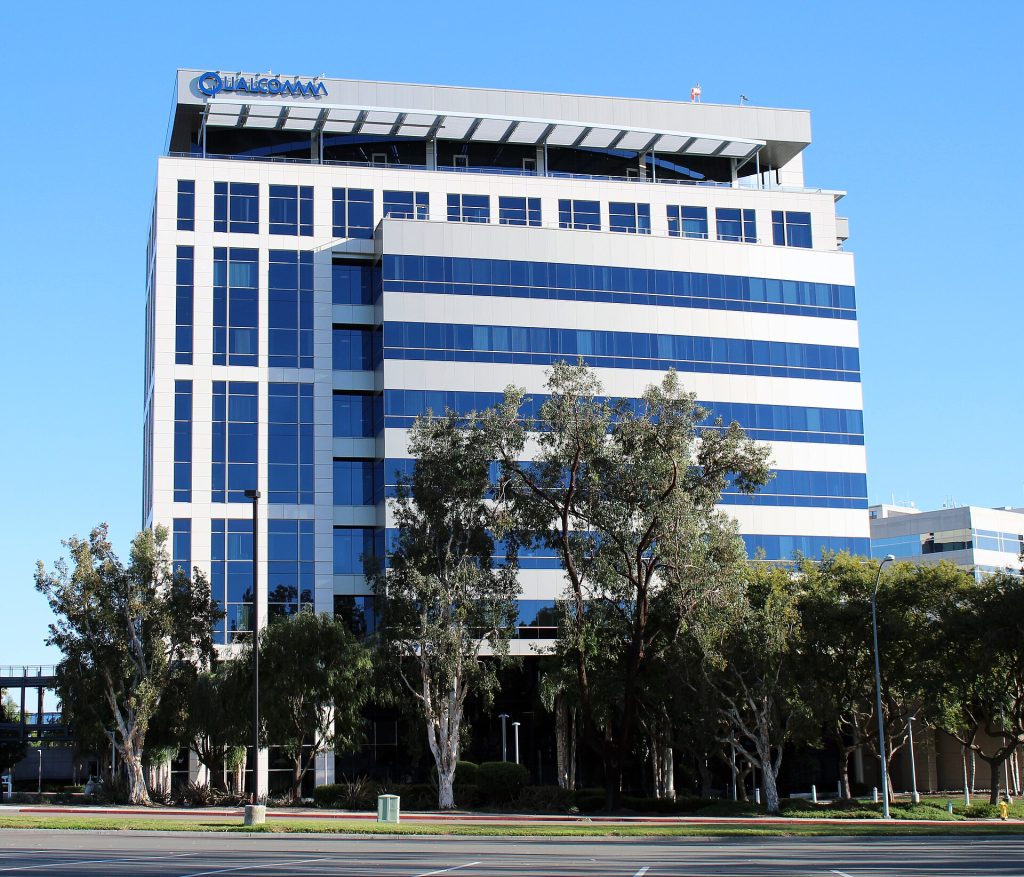
By Coolcaesar – Own work, CC BY-SA 4.0, https://commons.wikimedia.org/w/index.php?curid=52572757
From La Jolla to OmniTRACS: Qualcomm’s First Dream
In the summer of 1985, with the sea breeze of La Jolla lingering late into the night, communications theorist Irwin Jacobs (founding CEO) and Andrew Viterbi (co-founder) gathered with five others around a small desk to launch a new company. They named it Qualcomm—short for “Quality Communications.”
Their first dream wasn’t the cell phone. Instead, it was OmniTRACS, a satellite-based terminal that could locate long-haul trucks and transmit messages. The gray metal box that sat atop trucks was heavy and clunky, but its signal pierced the sky with precision. In 1988, before 300 logistics executives in San Diego, Qualcomm’s demo worked flawlessly—and the air in the room shifted. Months later, Schneider National, one of the largest U.S. trucking firms, signed a 5,000-unit contract. The revenue kept the lab lights burning late into the night, fueling experiments with a new wireless access method: CDMA.
Betting on CDMA Against the Odds
With OmniTRACS funding in hand, Qualcomm pushed CDMA research into the open. The industry was leaning toward TDMA standards, and “code-division” was dismissed as heresy. Yet Qualcomm answered skeptics with real-world trials.
Large-scale tests in San Diego (1989) and New York (1990) culminated in the 1995 IS-95 (cdmaOne) standard, ratified by TIA. On paper, it was just formulas and specifications. In reality, it was the story of a small company forcing open a second frontier in wireless technology.
Reinventing the Business Model
The mid-1990s brought a painful challenge. Building infrastructure and devices in-house strained Qualcomm’s limited manufacturing experience. In 1999, the company made a radical pivot: it sold its infrastructure division to Ericsson (with 1,200 staff transferring) and in 2000 offloaded its handset business to Kyocera.
What remained was a sharper focus: chips, patents, and system software. Qualcomm transformed almost overnight into a company powered by two engines—QCT (chipsets) and QTL (licensing).
Battles Over Patents and Policy
As Qualcomm doubled down on IP, tensions mounted. Licensing terms, royalty rates, and the “no license, no chips” policy drew scrutiny.
In 2019, the FTC won its antitrust case against Qualcomm, shaking its model. But in August 2020, the Ninth Circuit Court of Appeals overturned the ruling, finding no evidence of anticompetitive harm. This preserved Qualcomm’s dual-engine model and marked a turning point in its survival story.
Lessons from Failures and Pivots
Not every bet paid off. MediaFLO, Qualcomm’s mobile TV service, launched with fanfare but fizzled. By 2011, the company shut it down and sold its 700MHz spectrum to AT&T for $1.925 billion. A retreat in the short term became fuel for future 4G investment.
Snapdragon and the Stage
At CES 2013, then-CEO Paul Jacobs revealed a different Qualcomm: part showman, part chipmaker. The Snapdragon 800 demo, featuring quad-core 2.3GHz performance and 150Mbps LTE-Advanced, signaled Qualcomm’s ambition to step into the user experience spotlight—not just remain the “chip behind the curtain.”
Surviving Hostile Takeovers and Broken Deals
2018 brought drama: Broadcom’s hostile takeover attempt. U.S. regulators blocked the deal, citing national security concerns. That same year, Qualcomm’s planned NXP acquisition collapsed after China withheld approval. These setbacks underscored how wireless standards, semiconductors, and geopolitics are tightly bound.
The company responded the only way it could: accelerating its roadmap.
Apple, 5G, and Strategic Settlements
2019 finally ended Qualcomm’s global legal war with Apple. The settlement included a six-year licensing deal (plus a two-year option) and a multi-year chipset supply agreement. This cleared the path for the 5G iPhone. With disputes behind it, Qualcomm doubled down on integrating modems, RF front-end, and processors into a vertically stacked platform.
Intelligent Connected Edge: A New Era
In 2021, Cristiano Amon took over as CEO, sharpening Qualcomm’s vision: the “Intelligent Connected Edge.” Beyond smartphones, Qualcomm targeted cars, PCs, XR, and industrial IoT.
The acquisition of NUVIA in 2021 brought CPU design talent, seeding Qualcomm’s Oryon cores. In 2023, the Snapdragon X Elite debuted, powering Microsoft’s first wave of Copilot+ PCs in 2024. For the first time, Qualcomm was competing head-on in the PC silicon arena—with CPU, NPU, and modem all under its own design.
Expanding into Automotive
Meanwhile, Qualcomm’s Snapdragon Digital Chassis became the brain of software-defined vehicles—covering infotainment, connectivity, and ADAS. Its automotive design pipeline grew from $30 billion in 2022 to $45 billion in 2024, backed by deals with BMW, Stellantis, and Mercedes-Benz. By 2029, Qualcomm expects $8 billion in annual automotive revenue.
The RF Advantage
Inside smartphones, 5G reshaped the RF landscape. Qualcomm integrated modems with RF front-end and antennas, capturing market share. In FY2022, its RFFE business earned $4.3 billion, redefining how margins are distributed in the wireless supply chain.
A Company Defined by Survival and Expansion
Every risk carried backlash. MediaFLO’s failure exposed the limits of direct consumer services. Broadcom’s takeover attempt highlighted the link between R&D and national security. The FTC and Apple disputes revealed the fragility of Qualcomm’s licensing model.
Yet these very struggles clarified Qualcomm’s identity: a company weaving together standards, silicon, RF, and platforms into one roadmap. Qualcomm calls it simply: “One Technology Roadmap.”
Full Circle: From OmniTRACS to the Edge
Return to that summer night in 1985: a satellite terminal on a truck showed how connection changes work. That spark carried Qualcomm through 2G to 5G, through Nasdaq listings, restructurings, court battles, and global power plays.
Today, in San Diego, the whiteboards carry notes on the next 3GPP release, Oryon core optimization, and software timelines for automotive partners. CEO Cristiano Amon works to reduce dependence on smartphones while expanding into PCs, cars, and IoT. Qualcomm remains a believer in the idea that connection + computation = experience.
In short, Qualcomm’s story is one of survival, reinvention, and relentless expansion. From routers to trucks, from cell towers to cars and laptops—Qualcomm has always been about one thing: making connections last longer and go further.

By Original: Qualcomm – https://www.qualcomm.com/media/documents/files/4g-5g-summit-keynote-cristiano-amon.pdf, Public Domain, https://commons.wikimedia.org/w/index.php?curid=13514127
